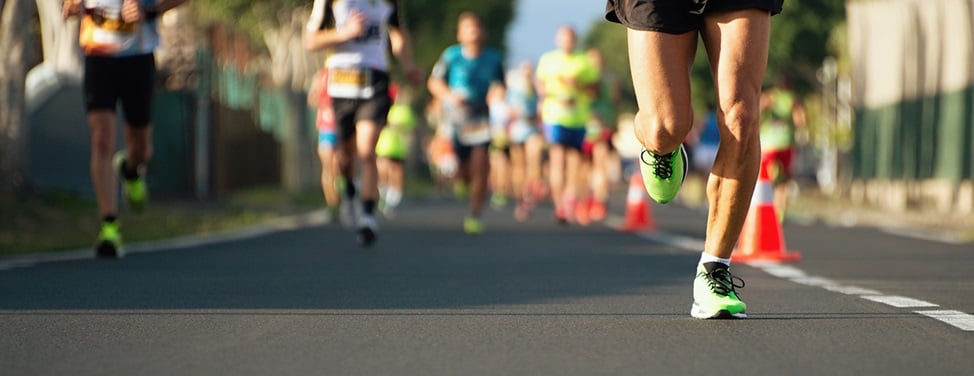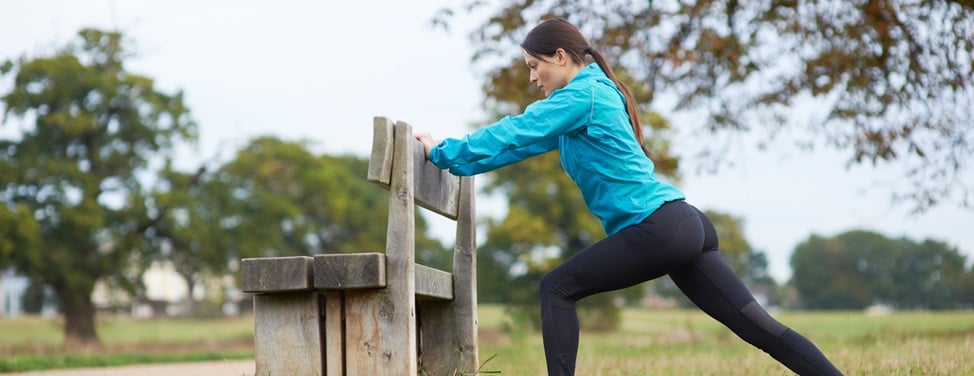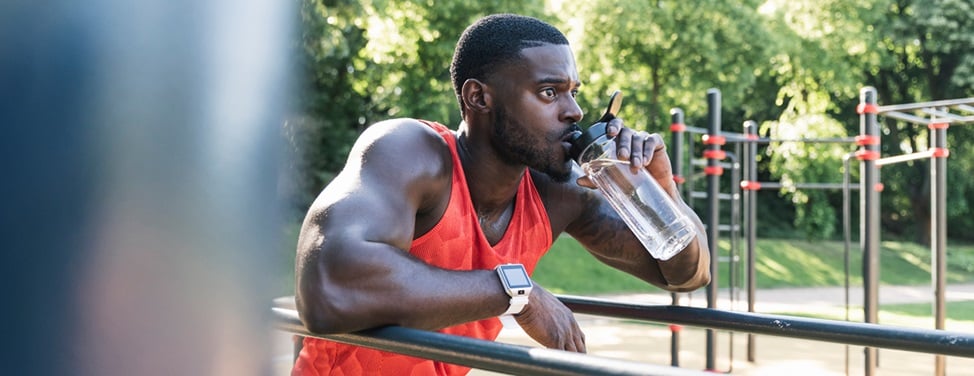
Winning Sports Nutrition
Physically active individuals have special nutritional needs. Learning what and when you should eat and drink may improve your performance. Eating right can help you feel good and stay fit throughout your lifetime.
Activity definitions
- Endurance. Vigorous, continuous activity for an hour or longer. Examples are distance running, cycling and cross-country skiing.
- High intensity. Short bursts of maximum or near maximum effort. Examples include weight lifting and sprinting.
- Moderate. Physical exertion difficult enough to increase your heart rate and cause heavy breathing, but easy enough to sustain for more than 30 minutes. Examples include aerobics, playing basketball and brisk walking.
- Low intensity. Everyday activities that involve movement of major muscle groups. Examples are walking up stairs, walking to the store and washing the car.
How activities affect calorie and protein needs
The best diet for all athletes consists of 55 percent to 65 percent of total calories from carbohydrate, 25 percent to 30 percent from fat and 10 percent to 20 percent from protein.
- Endurance. The energy demands of endurance activities are high. It is important that the body has adequate fuel stores for activities of long duration. For elite athletes, such as marathon runners or triathletes, energy needs are often as high as 3,000 to 5,000 calories per day. These athletes also have increased protein needs. Once the body's carbohydrate stores are depleted, muscle protein is broken down for energy. If you regularly perform endurance activities, your calorie and protein needs are at the upper end of the recommended range.
- High intensity. High-intensity sports affect nutritional needs in different ways based on the activity and the person's body size. These athletes have increased calorie needs, though not as high as endurance athletes. Weightlifters do need more dietary protein than the average person. In fact, protein intake in excess of the recommended levels does not increase muscle mass or strength and can lead to dehydration, osteoporosis and kidney disease.
If you are performing high-intensity activities on a regular basis, your calorie needs are at the middle of the recommended range and your protein needs are at the upper end of the recommended range. - Moderate intensity. Moderate-intensity sports increase your caloric needs depending on the frequency and duration of your activity. In general, be sure you are consuming adequate calories by eating at least the lower end of the recommended range. Consistently under-eating will eventually lead to fatigue and hinder your athletic performance.
- Low intensity. Low-intensity activities do not alter calorie and protein needs. These activities are important to include on a daily basis for general health benefits.
Energy and protein ranges for active individuals
To calculate your calorie needs:
- Divide your body weight in pounds by 2.2 to get your weight in kilograms.
- Multiply your weight in kilograms by 27 to 30 (depending on your activity level).
- Add 100 calories for every 10 minutes of activity you do on an average day.
To calculate your protein needs:
Multiply your weight in kilograms by 1.0 to 1.2 (depending on your activity level) to get the total grams of protein you need each day.
Example:
For a woman who weighs 140 pounds and runs an average of 60 minutes a day, five days per week, and lifts weights twice a week:
- 140 / 2.2 = 63.6 kilograms body weight
- 63.6 x 28 = 1780 calories per day
- 1780 + (6 x 100) = 2380 calories per day
- Protein needs: 63.6 kilograms x 1 gram of protein = 64 grams of protein per day
Eating before you exercise
For all types of physical activity, aim to eat a small, balanced meal two to four hours before you exercise. This will supply your muscles with adequate energy and allow your digestive system time to break down the food and make it available for energy.
Choose a meal high in complex carbohydrates, moderate in protein and low in fat.
Carbohydrate definitions:
- Simple carbohydrates. Single or double units of sugar that are quickly and easily absorbed by the body to be used for energy. Examples include hard candy, soda and jelly.
- Complex carbohydrates. Also known as starch, these are composed of many sugar units that the body must split into single units to use for energy. Examples include pasta and bread.
Sample pre-event meals
- 1 cup whole grain cereal, 1 cup nonfat milk, 1 banana and 6 ounces low-fat yogurt
- Turkey sandwich with two slices of whole grain bread, 4 ounces of turkey breast, lettuce and tomato slices, 1 tablespoon of mustard and 10 pretzels
Other tips
- Avoid foods that are especially high in fiber, such as raw vegetables, dried fruits, and nuts.
- Never try a new food on the day of a race or performance.
- Always consume adequate fluids throughout the day of your event.
- Avoid gulping large amounts of water at a time. This may cause bloating that can slow you down or cause stomach cramps. Aim for 1/2 cup fluid every 20 minutes during exercise.
- If you are not able to have a meal two to four hours prior to exercise, have a snack one hour before competition that is high in complex carbohydrates, moderate in protein and low in fat. Good choices are a granola bar with 8 ounces of orange juice or a peanut butter and jelly sandwich.
When exercising early the next morning
- The night before, eat a large well-balanced dinner that is high in complex carbohydrates and also contains some protein and fat.
- Eat a high-carbohydrate snack about an hour before going to bed, such as a banana or 6 ounces of yogurt.
- If possible, consume a small high-carbohydrate snack first thing in the morning, such as one slice of whole grain toast with jam or 8 ounces of juice.
Eating while you exercise
For endurance activities, you will need a source of energy during the event. This should be a simple carbohydrate that can be rapidly absorbed and utilized by the body.
When your activity will exceed 90 minutes, aim to consume 15 grams of carbohydrate every 30 minutes. Good sources include high-carbohydrate sports drinks, energy gels and certain sugary candies. Be sure the item you choose does not contain fructose. This type of sugar often causes stomach cramps, gas and diarrhea, which can hinder performance and cause abdominal pain.
Eating after you exercise
Recovery eating should be considered an essential part of training for all activities. Research shows that athletes who ate a recovery snack on a regular basis immediately following a training session had decreased muscle soreness and improved nutrient utilization, which led to improved performance at their next training session.
- Eat a high-carbohydrate, moderate protein and low-fat snack within 15 minutes of completing exercise. This snack should provide between 200 to 300 calories. Examples include an 8-ounce glass of chocolate milk, a banana or whole grain bread topped with peanut butter, or low-fat yogurt with a spoonful of granola or almonds.
- Consume a well-balanced meal within two hours after completing exercise. If you have completed endurance or high-intensity exercise, this meal should be high in calories to account for the extra energy used in your activity.
Try the following recipe for a homemade recovery smoothie. In a blender, combine:
- 1 cup nonfat milk
- 1/4 cup low-fat yogurt of choice
- One banana
- 1/2 cup strawberries (sliced)
- 1 tablespoon of chocolate syrup
- Two to four ice cubes, depending on desired consistency
- For added protein, also add 1 tablespoon of nonfat dry milk powder
Makes one serving with the following nutritional breakdown: 260 calories, 12 grams protein, 1 gram fat.
Water needs and activity
During physical activity, water has many important functions. It serves to cool the body, maintain adequate blood flow to working muscles and allow for the body's basic functions to continue to work. Relying on sense of thirst will not keep you properly hydrated because the body's thirst mechanism is dulled during exercise. By the time you feel thirsty, you are already in a state of mild dehydration.
Use the following tips as a starting point for remaining adequately hydrated. Then monitor weight changes and the color of your urine to determine your own fluid needs following activity. When you are properly hydrated, your urine will be clear or very pale in color. When your body is dehydrated, your urine will be a darker shade.
- Before exercise. Drink 20 to 40 fluid ounces (or 3 to 5 cups) of water over the two to three hours before activity and another 4 to 8 ounces every 15 to 20 minutes prior to starting exercise.
- During exercise. Consume 4 fluid ounces (1/2 cup) of water for every 20 to 30 minutes of activity.
- After exercise. Immediately after exercise, drink 16 fluid ounces (2 cups) of water for every pound of weight lost. This requires that you weigh yourself before and after exercise. Since this may not be practical in some situations, weigh yourself before and after an activity, when you have access to a scale and use this as a basic guide.
The best replenishment drink is water. Sports beverages can be used, though they can be high in sugar and calories. These drinks are only beneficial if you have performed an endurance activity for more than 60 minutes or if you are exercising in an especially hot or humid climate.
Learn more
Learn more about sports nutrition from these sources:
- Endurance Sports Nutrition, by Suzanne Girard Eberle
- Play Hard, Eat Right, by Susanne Steen and Debbi Jennings
- High Performance Nutrition, by Susan Kleiner
- Nancy Clark's Sports Nutrition Guidebook, by Nancy Clark
UCSF Health medical specialists have reviewed this information. It is for educational purposes only and is not intended to replace the advice of your doctor or other health care provider. We encourage you to discuss any questions or concerns you may have with your provider.












